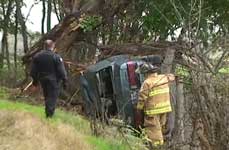How to Drive a Car | Avoiding a Rollover
Learning how to drive a car is also about learning how to keep your car in control and not only about avoiding other cars. Several manoeuvres you practice as you learn to drive are to give you practice in keeping the car in control. Turns for example have the potential for causing a rollover if you are going too fast when driving a car.
.
.
.
7 Tips for Avoiding a Rollover When Driving a Car:
- Drive a vehicle that is less likely to roll over.
- Use high-traction tires (“AA” is the highest traction rating) and make sure they are maintained in good condition.
- Rollovers are often speed-related so remember to control your speed when driving a car. Maintain the speed limit. Slow down in bad weather. Handle curves appropriately.
- Don’t drive impaired. Alcohol and drug-use often contribute to rollovers.
A Rollover Crash - Load vehicles properly. Shifting loads are a big factor in rollover crashes. Your Owner’s Manual will tell you the maximum load recommended for your vehicle, and the best way to distribute the load.
- If you’re using a roof rack: pay special attention to the manufacturer’s instructions and weight limits. Any load placed on the roof will be raise the vehicle’s center of gravity, and increase the chances of a rollover crash.
- Practice the recovery techniques. Make it part of your “Learning to Drive” checklist. Look for more information in the Driving Lessons sections of the Workbook and the Video Library. Click the link below to go to Driving Lesson 13.
Learn To Drive: Driving Lessons Video Library
| Nearly 75% of all rollover crashes occur in rural areas. As you learn how to drive a car use extra caution on rural roads. |
3 Tips for Minimizing Injuries in a Rollover:
- Always wear your seatbelt and do it up properly. Make sure all the other passengers are belted too so they don’t injure you or other passengers.
- Drive a vehicle equipped with rollover airbags.
- Secure loose objects so they don’t become projectiles in a rollover crash.





